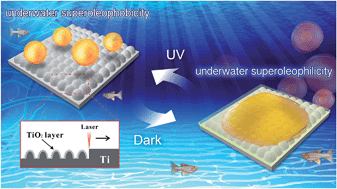Photoinduced switchable underwater superoleophobicity–superoleophilicity on laser modified titanium surfaces†
Abstract
Switchable underwater superoleophobicity–superoleophilicity on femtosecond laser-induced rough TiO2 surfaces by alternate UV irradiation and dark storage is achieved for the first time. Femtosecond laser ablation not only forms a micro/nanoscale hierarchical rough structure but also oxidizes the Ti materials, resulting in a rough TiO2 layer covering on the surface. The reversible switching of underwater oil wettability is caused by photoinduced switching between superhydrophobic and superhydrophilic states in air. These rough TiO2 surfaces can even respond to visible light. We believe this subtle switching method will be potentially applied in the biological and medical fields.


 Please wait while we load your content...
Please wait while we load your content...